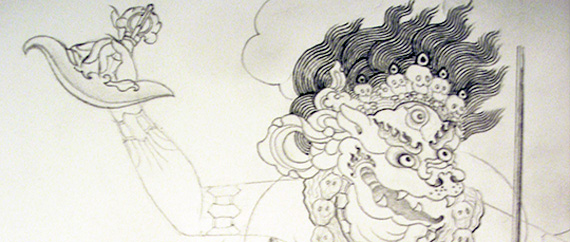About
Biography


Cynthia Moku paints in contemporary and traditional classic formats
Abridged Biography
As a contemporary artist with training in eastern and western painting traditions, Cynthia’s work responds to a global community. It is culturally diverse, multi-faceted and technologically advancing.
Cynthia’s contemporary ink-art paintings and outdoor environmental performances reflect her unique and singular training in Japanese calligraphy under two great Japanese Brush Masters of the 20th century, Eiichi Okamoto Sensei and Zen Roshi Kobun Chino Otogawa. Emerging from her training with these two Masters, Cynthia took her love of eastern brushstroke art into group meditation retreats, by guiding yogin practitioners in daily contemplative sessions known as ‘Indelible Presence Brush’. Sample photos from many years of such retreat practice can be seen in Indelible Presence: The Way of the Brush.
Stemming from these reflexive practices, ‘One Continuous Gesture’ has emerged as public performance group sessions done in a variety of public indoor & outdoor environments. These shared brushstroke gatherings are done with the intention of connecting wisdom traditions and local communities through the contemplative art of brushstroke practice.
Cynthia brings her contemporary artwork to the forefront through painting sequences such as; Flying White, Pilgrimage, Sky Dancers, Maitri Seed Series, and Gestures of Engagement. Examples of these works and others, can be seen in Portfolio.
Her current field of interest is coming forth through commissioned modular-mural paintings for public spaces, such as the GEM Series shown in the Depth Perception Collection. These immersive holographic wall artworks, inspired by the symbolism and ancestral stories of time-honored wisdom traditions, are simultaneously delving into the real-time relationship between visual perception and direct experience as we view and move before their holographic effect. You can see these fresh exploratory works in the Depth Perception Collection.
In her eastern traditional works, Cynthia has directed large-scale projects associated with the Himalayan Buddhist tradition for more than fifty years. This includes designing and directing interior mural paintings for the three major public stupas in the United States all located along the Rocky Mountain range.
In the 1960’s as an art student in the Academies of San Francisco, Cynthia trained in western painting and drawing disciplines including: classic painting techniques, anatomy, graphic design and theory. During this cultural and spiritually stimulating time, classic eastern art forms captured her attention. The specific techniques and scope of philosophical understanding, held within these artistic traditions, provided an untapped medium through which she could articulate her work.
Pursuing this interest and continuing her training in meditation, she met the renowned meditation master and dharma teacher, Kyabje Kalu Rinpoche. Under his prompting and instruction, Cynthia began a life-long study and practice in meditation and the emblematic art of the illustrated dharma. Commissioned by both Tibetan and American spiritual teachers, her thangka paintings reside across the globe.
This includes the seminal painting of the Protector Chagdrukpa Mahakala, acquired by the Denver Art Museum and consecrated by His Holiness the XIV Dalai Lama. This piece has the distinction of being the first thangka in the Karma Ghadri style of Himalayan Buddhist scroll painting acquired by a major American art museum for its permanent collection, that states, ‘Country of Origin, the United States of America’.
Along with her artwork, as an educator, Cynthia has taught contemplative art disciplines and guided meditation sessions in the United States and Europe, including designing and implementing Naropa University’s Bachelor of Arts Degree in the Visual Arts.
Media
Buddhist Door Global
Vivid Realizations: A Journey Through Buddhist Art
The Middle Way Initiative
Mere Appearance, Prajnaparamita Illustrated
Shambhala Mountain
On-line interview
Shambhala Times
A four-part article